Sandeel fishing: consultation
We are consulting on proposals to close fishing for sandeel in all Scottish waters. This paper explains the background of the consultation, options considered, and outlining the questions for respondents.
5. Sandeel and their role in the marine ecosystem
5.1 Background
Sandeel represent the most abundant and important forage fish in the North Sea and play a key role in North Atlantic marine food webs[26]. Variations in the abundance and availability of sandeel or other forage fish can have important effects on both ends of the marine food web (top-down regulation of lower trophic levels and bottom-up effects on marine predators such as mammals, seabirds and predatory fish).
The total stock biomass of sandeel has shown an overall decline over the last three decades. Climate change has the potential to further affect sandeel abundance and their availability to marine predators. Reduced pressure from industrial fishing could provide benefits through increasing the resilience of sandeel to other environmental pressures.
5.2 Predatory fish
Sandeel is a prey species for some whitefish species (e.g., cod, whiting, haddock). Initial analyses of fish stomach contents (ICES 1997) concluded that sandeel constituted up to 20% of age 1 cod diet in July-September and between 5-10% of the diet in other age classes in April to September, when sandeel actively feed. In haddock, sandeel constituted >50% of age 0 fish in April to June and between 40-50% of the diet for all other age classes in July to September. In whiting, sandeel composed around 45% of the diet of all age classes in April to June and decreased to around 20% in July to September. Whiting body condition was found to be correlated with the amount of sandeel present in their stomachs[27] and their spatial distribution was found to be influenced by sandeel, with whiting found to aggregate near sandeel-rich areas[28] [29]. Furthermore, the amount of sandeel consumed by predators will also depend on predator stock abundance and their spatial distribution.
5.2.1 Cod
Atlantic cod (Gadus morhua) is considered as a sandeel reliant fish as reported in ICES (1997) and is distributed broadly across North Atlantic waters. In Scottish waters significant aggregations are found off the Moray Firth, the Northern Isles as well as areas off Rattray head and Buchan Deep[30]. An estimation of the distribution of cod spawning grounds highlights the presence of several recurrent and occasional cod spawning grounds in Scottish waters (Figure 3).
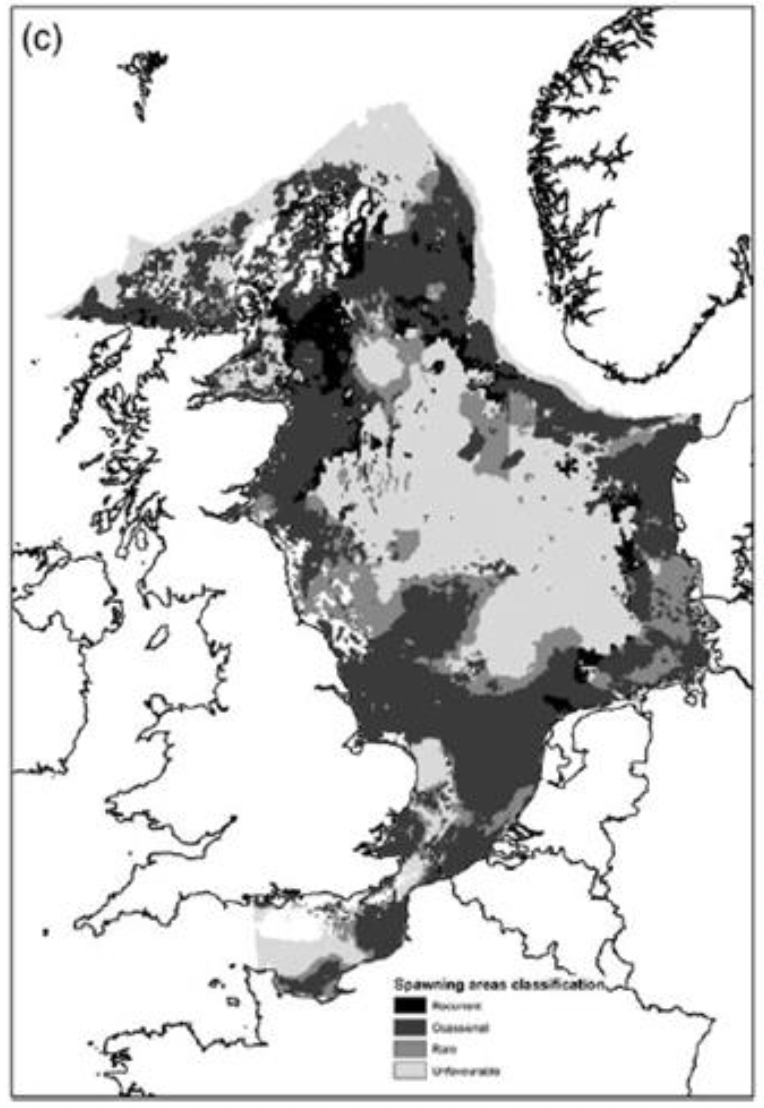
5.2.2. Haddock
Haddock (Melanogrammus aeglefinus) is considered as a sandeel reliant fish as reported in ICES (1997) and is distributed broadly across North Atlantic waters. In Scottish waters, significant aggregations are found off the Moray Firth and along the East coast of Scotland and to the West of the Hebrides particularly for age 5 and older[32]. An estimation of the distribution of haddock spawning grounds highlights the presence of a number of recurrent and occasional haddock spawning grounds in Scottish waters (Figure 4).
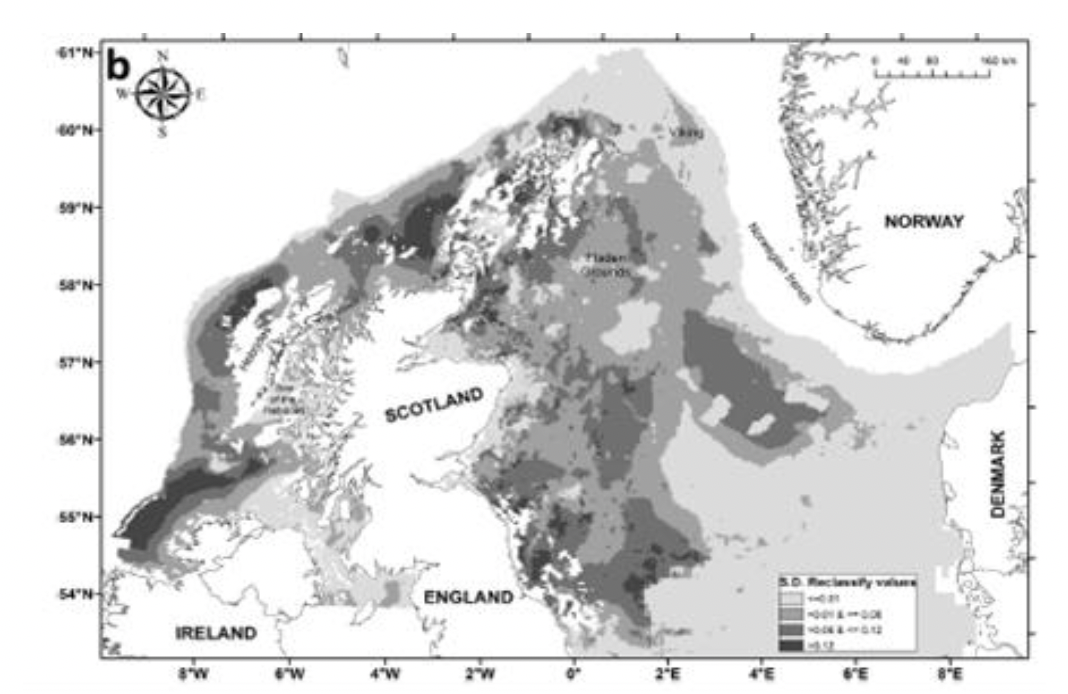
5.2.3 Whiting
Whiting (Merlangius merlangus) is considered as a sandeel reliant fish as reported in ICES (1997) and is predominantly found in the North Sea. In Scottish waters, significant aggregations are found off the Moray Firth and along the East coast of Scotland. An estimation of the distribution of whiting spawning grounds highlights the presence of a number of persistent and occasional whiting spawning grounds in Scottish waters, particularly around the Northern Isles and off the East coast of Scotland (Figure 5).
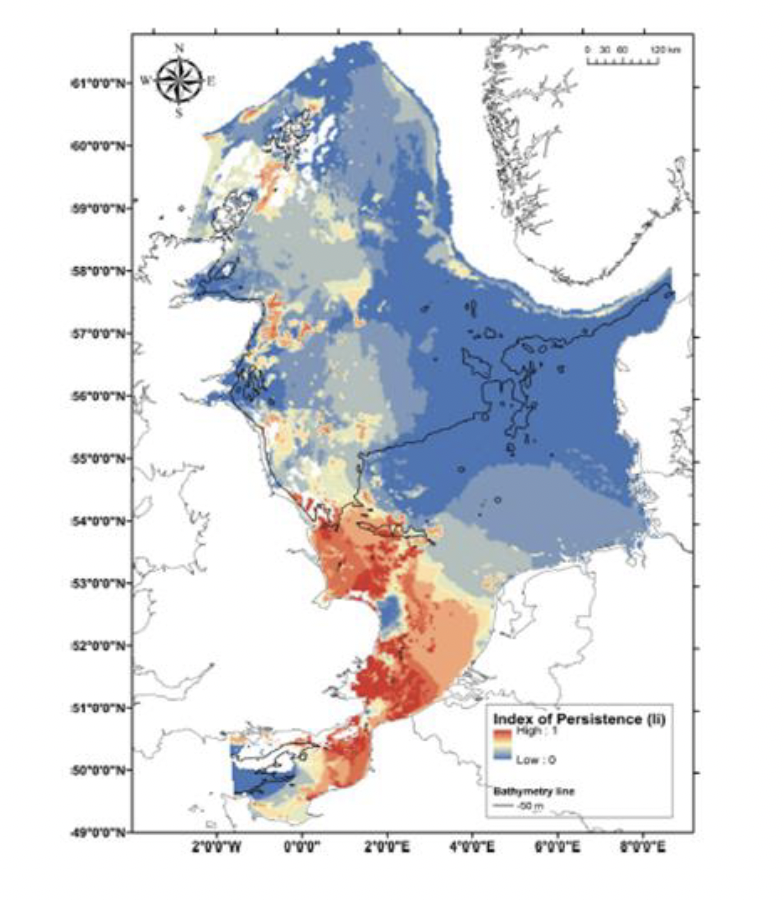
Predatory fish are often generalist feeders, switching between prey species based on availability[35]. The importance of sandeel as a food source is more variable for predatory fish than for seabirds and mammals [36]. Some fish species such as whiting, haddock, cod, plaice, lesser weever, and grey gurnard have shown higher body condition indices or growth in years of high sandeel abundances [37] [38]. Body condition relates to growth, survival and reproduction and can thereby affect fitness and abundance of these predators.
However, complex environmental interactions, including dynamics in predatory fish populations, competition for food sources, cannibalism and climate change may also affect the abundance of sandeel in the North Sea, making prediction of sandeel stock development following a fishery closure difficult[39] [40] [41] [42] [43] [44] [45].
5.3 Seabirds
Scotland supports internationally important populations of breeding seabirds, with 24 species regularly breeding in Scotland[46]. However, in recent decades many seabird populations have suffered substantial declines, with seabirds in the Greater North Sea not achieving GES in the most recent UK Marine Strategy assessment[47].
A large proportion of seabird species in Scotland include sandeel in their diet during the breeding season, although the extent to which seabirds are dependent on sandeel varies across species, with gannet (Morus bassanus) identified as having low sensitivity to sandeel abundance and kittiwake (Rissa tridactyla) high sensitivity.
During breeding, many Scottish seabird populations exploit seasonal peaks in sandeel abundance, feeding on both adults (1+ age group) and juveniles (young-of-the-year; age 0). For example, on the Isle of May, Firth of Forth, sandeel comprised approximately 75% of the breeding season diet of shag (Phalacrocorax aristotelis), kittiwake and puffin (Fratercula arctica) between 1991 and 2011[48] . Sandeel also constituted a substantial proportion of the diet of seabirds breeding on Canna, Western Isles between 1981–2007. Over this period sandeel were the greatest component (62%) of regurgitations from young shag and adults feeding chicks, comprised a quarter of young guillemot (Uria aalge) diet, and occurred in 60% of kittiwake regurgitations, being the commonest fish family in 14 of the 20 years in this latter seabird species' diet[49].
The ability of seabirds to prey on sandeel will depend on both the absolute numbers of sandeel (stock biomass) and the availability of sandeel to seabirds. However, understanding the extent to which seabird demography (breeding success, survival, and population size) is determined by sandeel abundance and availability to seabirds, and hence the potential benefits that a sandeel fishery closure might bring for seabirds, is not straightforward.
A consistent pattern in the way seabird breeding success changes with forage fish abundance has been reported for many seabird-forage fish interactions around the globe. Known as 'one-third for birds', studies found that seabird breeding success vary little or not at all at intermediate and high forage fish abundance, but once forage fish abundance dropped below a threshold of one-third of maximum biomass, seabird breeding success rapidly declined[50]. This relationship has also been found for seabirds feeding on sandeel, e.g., for breeding success of Arctic skua (Stercorarius parasiticus, great skua (Stercorarius skua) and kittiwake on Foula in relation to the Shetland sandeel total stock biomass[51] A similar relationship has also been found for a proxy of adult survival at the Isle of May for kittiwakes[52].
Seabird breeding success is also influenced by the availability of prey. Seabirds are constrained in the distance from nest sites that they can forage (when breeding) and the depth in the water column that they can reach. Prey therefore needs to be within foraging range and within dive depth; both of which vary among seabird species. Similarly, prey of the right age or size class must be available at the right time of year for provisioning to chicks. For example, kittiwake tend to feed on age 1+ sandeel in April and May, shifting to age 0 sandeel in June and July, with highest breeding success occurring when age 0 sandeel appeared early in the season. To be of most benefit to seabirds, the peak in sandeel abundance needs to coincide with the seabird chick rearing phase of the seabird breeding season. However, the timing of sandeel availability and absolute abundance shows inter-annual variation, which can result in a mismatch between peak sandeel availability and seabird chick rearing and negative effects on seabird productivity. Some seabird species are more able to switch prey species than others, for example guillemot switch prey species more easily than kittiwake, which may help mitigate some of the negative effects of reduced or mismatched sandeel availability.
Establishing a relationship between industrial sandeel fisheries and seabird demography is challenging. Fishing mortality is only one factor influencing sandeel stock biomass, with natural predation by other fish, marine mammals and seabirds, copepod prey abundance, and wider environmental conditions key factors. Furthermore, lag effects between seabird demography and environmental conditions can increase complexity and uncertainty.
On two occasions sandeel fisheries have been closed due to concerns about their impacts on the breeding success of seabirds: the small sandeel fishery off Shetland in the 1990s and the Wee Bankie, Scalp Bank and Marr Bank fishery off south east Scotland in 2000. Kittiwake showed a statistically significant decrease in breeding success attributable to the south east of Scotland sandeel fishery (from 52% to 23% proportion of nests to young fledged), followed by a smaller but still statistically significant increase in breeding success (10%) when the fishery closed, compared with control colonies. Puffin, razorbill (Alca torda), and guillemot showed no negative effects of the fishery on breeding success, nor any positive effects following closure[53].
The positive benefits to seabird productivity and populations of a sandeel fishery closure are difficult to quantify because of the complex relationships between prey and seabird demography, ongoing climate-mediated changes in sandeel population (including from climate change) and the numerous other pressures that seabirds face (e.g., habitat loss, biosecurity, infectious disease (such as Highly Pathogenic Avian Influenza[54]), climate change, storm events[55], human disturbance to breeding birds[56] and predation of both chicks and adult seabirds[57]). There is also considerable variation across seabird species in their dependence upon sandeel and their ability to switch to alternative prey. However, despite these uncertainties, maximising abundance and availability of sandeel stocks as prey for seabirds in Scotland (by way of removing potential pressure from industrial fishing) remains a key mechanism by which resilience in seabird populations might be achieved.
5.4 Marine mammals
Sandeel are a key prey species for marine mammals in Scottish waters, comprising a large proportion of the diet of seals and some cetaceans[58] [59], although the importance of sandeel to marine mammal diet varies with species and season.
5.4.1 Seals
Grey seals (Halichoerus grypus) and harbour seals (Phoca vitulina) occur widely throughout Scottish and UK waters (Figures 6) and largely occur within the same ecological niches with some degree of regional spatial partitioning. This is marked by a notable overlap in diet throughout the UK populations where sandeel and large gadids are proportionally the most represented prey groups by weight, in both species [60] [61] [62] [63] [64] [65]. The at sea distribution of both harbour and grey seals overlaps with predicted sandeel habitat in UK waters (Figure 3).
Diet analysis studies have concluded that sandeel dominate the diet of grey seals in all regions during autumn and winter except for the Inner Hebrides where gadids predominated [66]. However, this dominance shifts to gadids and other benthic species during the spring and summer in Orkney and Shetland and drops from 22.2% to 8% of the diet of grey seals in the Inner Hebrides. For harbour seals, sandeel were also dominant but with regional variation, with sandeel dominant in harbour seal scats in the Moray Firth across all seasons, although sandeel became less important in more southerly regions with flatfish and gadids predominating in south-east Scotland, the southern North Sea and the Inner Hebrides. In addition, harbour seals from the Outer Hebrides and Shetland preferred pelagic species with sandeel only representing 13.1% and 23.7% of the diet in these regions during the spring and summer months. This prevalence does increase during autumn and winter in Shetland where sandeel become the preferred prey of harbour seals, representing 31.5% of their diet[67].
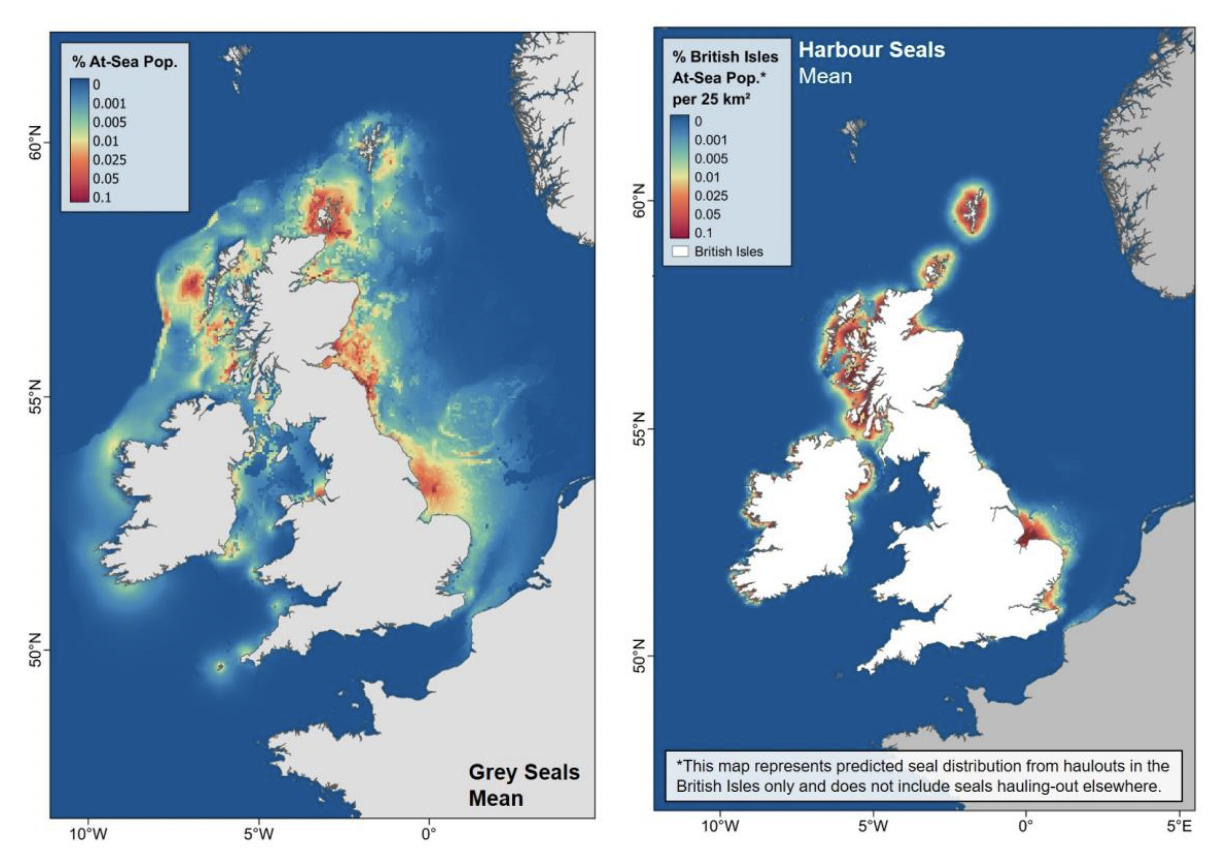
While grey seal populations down the east coast of the UK continue to increase, harbour seals are experiencing regional population declines (e.g., north and east coast of Scotland) resulting in harbour seals not achieving Good Environmental Status in the Greater North Sea[69]. Studies suggested that the decline in harbour seal abundance in the North Sea may be linked to a reduction in sandeel stocks. Specifically, there appears to be a correlation between regional declines of sandeel stocks (northern and eastern Scotland) and the declining populations of harbour seals in eastern Scotland and Orkney, where sandeel dominate the diet of harbour seals. This relationship with sandeel stock levels was supported by findings that the diet of harbour seals appeared more diverse in areas where harbour seals are not in decline. If sandeel are in short supply, it could be that grey seals may out compete harbour seals thereby contributing to their decline given grey seal preference for sandeel in these regions[70].
5.4.2 Cetaceans
Scottish waters support a diverse range of cetaceans[71] with sandeel and other forage fish forming an important part of the diet of many of these species including minke whale (Balaenoptera acutorostrata)[72] and harbour porpoise (Phocoena phocoena)[73]. Habitat maps of some cetacean species were generated in Scotland's Marine Assessment 2020 and show that cetacean habitat overlaps with sandeel habitat[74]. In particular, population density modelling of harbour porpoise (Figure 7) shows that this species has strong affinity with sandeel habitat.
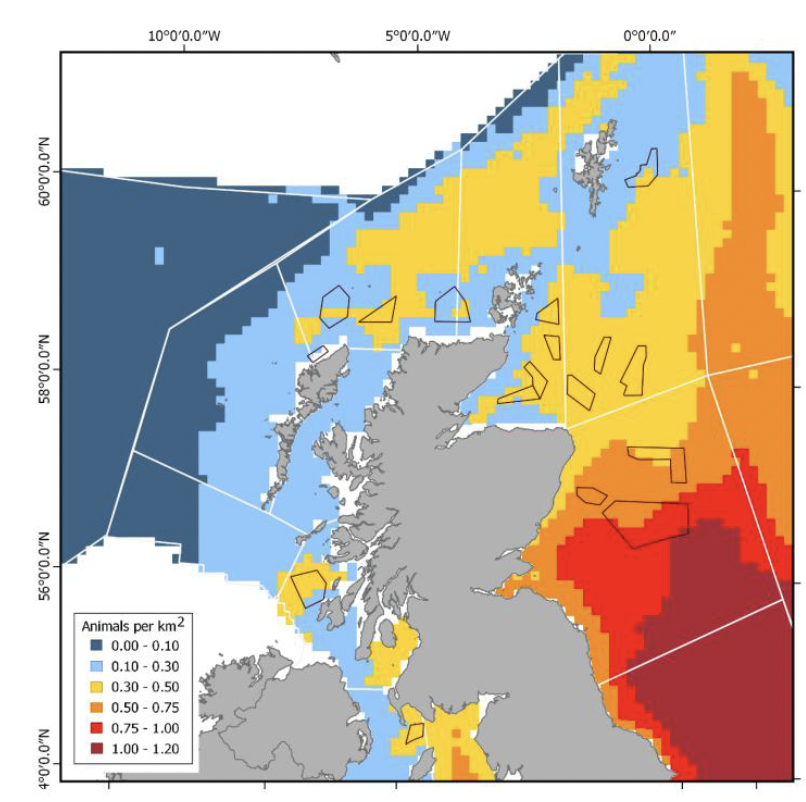
Harbour porpoises are widely distributed throughout Scottish waters, with in the highest observed densities of harbour porpoise in Scotland generally in the North Sea[75], where porpoises seem to prefer similar depth ranges as on the west, as well as sandy habitats that are typically favoured by sandeel, such as the gravelly sand seabed area of Smith Bank in the middle of the Moray Firth. Harbour porpoises in Scottish waters have been found to feed predominately on whiting and sandeel[76] with sandeel being particularly important during the spring and summer[77]. More recent diet data for harbour porpoise in the northern North Sea are unavailable. However, studies on stranded harbour porpoise in the southern North Sea[78] [79] found gobies, gadids, clupeids and sandeel to be the main diet components.
A diet study on stomach contents of ten stranded minke whales in Scotland showed that sandeel were the most important prey species and contributed two-thirds of the individual diet, by weight diet[80]. These findings have been supported by other studies in the wider North Sea region. A study found sandeel to comprise 86.7% of the weight of the prey species found in the stomach contents of minke whales caught by Norwegian whalers in 1999[81]. However, the proportion of sandeel dominance appeared to change between years.
White-beaked dolphins (Lagenorhynchus albirostris) are present in Scottish waters year-round, with a wide distribution that favours both offshore and nearshore areas depending on the region. The main areas of white-beaked dolphin overlap with high probability of sandeel occurrence is the offshore waters of the east coast, concurrent with increased sandeel availability in the water column during summer months where seasonal white-beaked dolphin density is also highest. Sandeel were present in a diet study of a small number of white beaked dolphins[82] but gadids are thought to be the predominant prey items in the North Sea[83] [84].
5.4.3 Vulnerability to sandeel variation
Sandeel are an abundant, but declining food source in much of the distributional ranges of the marine mammal species described above. However, the reliance on sandeel and subsequent susceptibility to fluctuations in sandeel abundance and distribution differ among marine mammal species. Furthermore, the varying vulnerability of marine mammals to declines in sandeel abundance is a complex and stochastic interaction between prey distributions, diet, predator and prey demography, and predator foraging distributions and behaviour so predictions are subject to considerable uncertainty.
Sandeel are a high-quality, lipid-rich prey source and improved body condition in marine mammals has been linked to the proportion of sandeel in their diet. For example, a correlation was found between harbour porpoises in better body condition and higher amounts of fatty fish in their diet[85] and, links between consumption of sandeel and health status of porpoises suggested that a decrease in sandeel availability could have negative effects on porpoise populations[86]. The predicted consumption of sandeel is high in porpoise diets, despite an abundance of other available prey species. Further, consumption of sandeel is significantly greater than all other prey types even when abundances are roughly equal[87].
Multi-species functional responses have been published which indicate that when energy rich prey-species (i.e., sandeel) are scarce, porpoises must increase the total biomass consumed to avoid shortfalls in energy intake[88] and by extension, poor body condition. As a result, minor differences in overall biomass and energetic intake were predicted between 2011 and 2022 (a period of pronounced sandeel decline in abundance across their range). Porpoise may subsequently travel greater distances or shift their ranges in search of a higher biomass of prey or increased densities of other high energy prey.
Declines in sandeel stocks could have implications on inter-specific competition between marine mammal species in situations where sandeel are the primary food source. If sandeel are scarce, the considerable overlap in diet between grey and harbour seals could result in exploitative competition which could impact one or both species. With harbour seals noted to be in significant decline in certain regions of Scotland, a depletion in sandeel stocks could be a factor in the further decline of harbour seals as indicated by the continuing decline in areas where seals show high preference for sandeels and little plasticity in diet[89].
5.5 Other fish caught by the sandeel fishery
Whiting and mackerel are caught as bycatches in the sandeel fishery; and whiting aggregate at sites of high sandeel abundance[90]. It is expected that any benefits to sandeel through the closure of the sandeel fishery may benefit whiting and mackerel also, although it is expected that these benefits would be to a lesser extent than for sandeel as they are not the target species of this fishery.
Contact
Email: sandeelconsultation@gov.scot
There is a problem
Thanks for your feedback